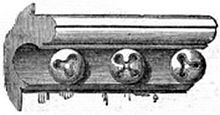design, passes through just under it. Below this is a panel of window tracery, and the lower stage of the buttress has another pedimented head. This kind of buttress, though commonly plainer, belongs to the Geometrical period. A much richer variety of the same kind occurs at the west front of Howden, where there is a canopied niche with a figure in it; and the buttress terminates in a turret pinnacle, with open-work, tracery, and a crocketed spire. In the later period of the style the buttresses are in many cases enriched with canopied niches, with or without figures, in both stages. Sometimes they have a plain set-off instead of a pediment; but in all cases they may be known by their peculiar mouldings. They are also repeatedly set on the angles of buildings diagonally, which is not the case with the preceding style.
The Pinnacles are numerous, and very fine. They are in general square, and not on diagonally; the sides are frequently panelled, and terminate in crocketed canopies, or gablets, from which rises the spire, which is also crocketed at the angles, and terminates in a finial. The foliage of the Crockets and Finials is loose and free, and has not the square, stiff form so observable in the Perpendicular.
The Pillars of this style in small churches are occasionally octagonal or plain round; but in large buildings they are very various in section. They have, at times, a number of small shafts surrounding a central pillar; but these shafts are, like those of the doors, cut out of the same block, and not detached, as in the Early English style. In some instances the central mass is a lozenge, and in others a square set diagonally. In some cases, as at Exeter, it consists of a number of equal-sized small shafts set round a lozenge body. The small shafts are repeatedly filleted.
The Bases have not the rounds and deep hollows which we find in the Early English, but are generally made up of rounds or roll mouldings.

Decorated Capital, from Selby.
The Capitals are important, and form one of the most valuable marks of the style. They are often without ornament, and can then be distinguished only by their mouldings. Sometimes they have the ball-flower, and occasionally heads or human figures; but the most usual design is a wreath or ball of foliage. In the Early English style we see the stems of the foliage rising from the neck mould, or astragal, and turning over under the abacus of the capital; but in the present style we have most commonly a stem with its leaves wrapped round the bell of the capital and filling up the space like a ball. The one here given from Selby is an excellent example of the general appearance of a rich decorated capital; but the foliage is infinitely varied. Sometimes it is long and flowing, encircling the whole capital of a clustered column; but in general it is a faithful copy of natural forms, the oak, the ivy, the maple, and the vine being the plants most generally copied; and this is done with great delicacy and grace. Decorated foliage, whether of capitals, corbels, or cornices, is greatly superior to that of any other style; and nothing can exceed the skill with which it is drawn and carved.
Arches.—These are not so acute as those of the Early English. The equilateral is the one most frequently used, but sometimes it is still lower. They are generally moulded, but the mouldings are in many instances bold quarter rounds, or filleted rounds, and sometimes the arches are merely plainly chambered. In a few instances the mouldings of the arch are carried down to the ground without the intervention either of capital or impost. In large buildings vaulting shafts are carried up the pillars to support the groining of the Roof, which is much more complicated than in the Early English. Numerous extra ribs are introduced, and richly carved bosses placed at the intersections, which give it much richness and variety. Many beautiful open timber roofs of this style still remain, both in churches and houses. Stone groining is imitated in wood in cases where it would not be safe to place the weight of a stone roof on the walls.

Ball-flower, with Roll Moulding and Hollow.

Four-leaved Flower with Filleted Round and Hollow Moulding.
The Mouldings and Ornaments are quite as important in this as any other period, as a means of distinguishing one style from another, and fixing the date of a building. The mouldings have lost the boldness of the Early English, but they have gained a greater neatness. The rounds are not so wide, and have frequently one, two, or Four-leaved Flower, with Filleted, Round, and Hollow Moulding. Sometimes three small fillets running along them. Another moulding, very peculiar to this style, is a round, the upper half of which projects over the lower; it is called the roll-moulding. There are also two ornaments which belong almost as exclusively to the Decorated as the zigzag to the Norman, or the tooth ornament to the Early
